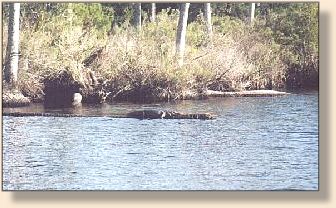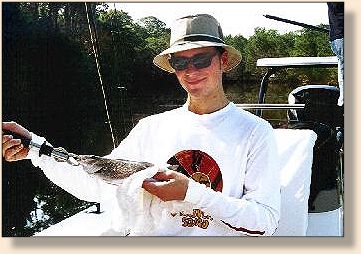I wanted to share an interesting charter a couple of weeks back. Tom
called well in advance to book the date. He said he fly-fished in upstate
New York, but that the two gentlemen joining him did not. That's fine.
I'm always happy to provide casting lessons either at the ramp or on the
water. It helps my clients and also helps me improve on skills I should
already know. It is amazing to me how few people actually practice
their casting. The more proficient casters will find a parking lot, a field,
or someone's backyard to practice casting technique. Like golfers,
they'll stand or sit in a den and just practice the speed up and stop (the
Lefty Kreh, paint brush method) without holding the rod. It works!
A couple of days before Tom's charter, I received a call from one of my
sponsors and they wanted me to take them out the same day. Only they
wanted to go out of Palm Coast (60 miles north of me and 25 miles north
of where I would fish Steve's party). So I moved my sponsor charter
to the afternoon and asked Steve to meet me at Sanchez Landing
(Strickland's Creek in Ormond Beach). That week was really packed
with 6 charters. But the best one was Tom's.
I arrived at Sanchez early, launched the boat and made preparations for
their arrival. I had six fly rods and two rods made ready for casting lessons.
A 7-weight, mid-flex 6.5 Orvis Silver Label (I think the better of the two
for teaching saltwater fly-fishing) and an 8-weight, tip-flex Redington
Wayfarer.
Strickland's Creek is about the size of a small river. It is tidal and the flow
can be strong at times. We were going out 90 minutes before the high tide.
Perfect conditions, except for an off moon phase (I really pay attention to
lunar conditions when fishing in saltwater) and a weather front that moved
through the day before. But Sanchez is a place of awesome beauty. Two
and a half miles northeast the creek joins Tomoka River and follows another
two miles to the Tomoka River Basin.
At 7 am Tom arrived with his two sons, Derek and Steve. You could see
the excitement in their faces and the expectations. One by one we did a
quick (10 minute) course in fly-casting. It is really difficult teaching someone
new to fly-fishing with each practice cast going into the water. Doing a wet
haul for the first time, I was surprised how Derek was able to pick the line up.
After about 15 minutes he successfully completed a double haul. He was
really determined. But we needed to get going. By 7:30 we were on our
way down Strickland's. Tom was in awe by the beauty of the creek and
the purity of this area. He was surprised that an area like this was located
so close to the beach. This is the real, natural Florida, the way the Spaniards
and English saw it.

The creek is lined by overhanging trees and sea grass at the water's edge.
Large palmettos (cabbage palms) form the front of the tree line with Live Oak
and Sugar Pine behind. During high water some of the palmettos will fall into
the water making boating a challenge. But it is not unusual to see a lazy gator
soaking up the sun on a downed palmetto. This area is abundant with all
types of wildlife including sea otters, raccoons, all types of birds and game
fish including 50 to 60 pound baby tarpon.
At the 'tarpon tree turn' (named by a friend) we were now drifting with the
outgoing tide. I helped Derek with casting on the bow and Tom practiced
his techniques at the stern. Steve sat back and let his father and brother
get into a groove.
The current took us to the opening at Tomoka River and then northeast and
under the Beach Street bridge. Just east of the bridge there is an opening to
the north and a small island. This area is part of the Mosquito Control District
Canals and provides great habitat for redfish, trout and tarpon. From the
poling platform, I scanned the waters edge. There, not more than 60 feet
away I say two large pushes, most likely redfish.
"Steve. There is a push right there at one o'clock. Do you see it?"
"Yes," came his answer. His face was lit up with excitement. He started his
cast, but couldn't manage the distance. I probably miscalculated, and it was
probably more like 80 feet. So I asked him to wait while I poled us closer.
Now it was evident that reds were pushing along the grass line. We took
a couple of more shots at them with no hook ups.
The thing with redfish, or any large game fish, is that you must lead them and
you must have long, accurate casts. Steve's problem with long casts is a
problem we all have - trying to push, or power, the line on the forward cast.
Forcing a cast just takes all the energy out of the line and it will collapse.
This is really frustrating and discouraging. New saltwater fly anglers need
to set realistic expectations. The most important part of the cast is your grip.
This is not a tennis racket - thumb goes on top of the cork.
Lefty says, "the thumb will determine where the cast goes." He is soooo right!!
Secondly, the motion of the cast is a speed up and stop - let the rod do the
work. Thirdly, you have to learn to double haul. Don't think you need this
in a mountain stream? Think again - wouldn't it be great if you didn't have to
get your feet wet or that you could haul a roll cast out 60 feet. Learning to
haul is the single best skill you can master. And, it isn't hard. And, it looks
so cool. If you have aspirations for bone fishing in the keys, learning to
double haul is a must.
We had a really interesting morning and couldn't land any of the big girls
on fly - but we saw the pushes and that is important as well. Luckily we
had some spinning rods and Steve saved a skunk by boating a really nice
Mangrove Snapper.
 I never heard of one caught in Tomoka River - so that's a first. I really
enjoyed this charter. Personally, I have a lot of respect and admiration for
fathers who take their sons fishing. It meant more to me that Steve did this
than he will know. When I asked if they had a good time. They all agreed
and Tom came back with, "This was a real learning experience."
I never heard of one caught in Tomoka River - so that's a first. I really
enjoyed this charter. Personally, I have a lot of respect and admiration for
fathers who take their sons fishing. It meant more to me that Steve did this
than he will know. When I asked if they had a good time. They all agreed
and Tom came back with, "This was a real learning experience."
Don't take it too hard - the point is to have fun, enjoy nature, and occasionally
your skills will improve to the point you'll get tired catching fish.
~ Doug
About Doug:
Capt. Doug Sinclair has relocated from New Smyrna Beach, Florida to
Grantsboro, NC. He specializes in fly-fishing and light tackle charters.
Doug charters the Coastal Carolina area of New Bern or Oriental.
Catch him on the web at
www.flyfishacademy.net or call him at (252) 745-3500.
Doug is also a Sponsor here on FAOL.
|

